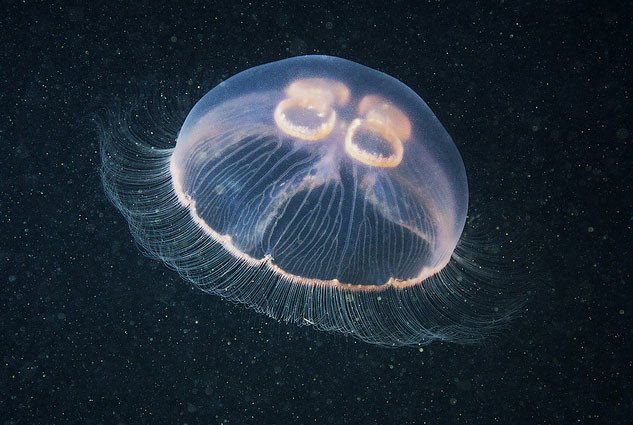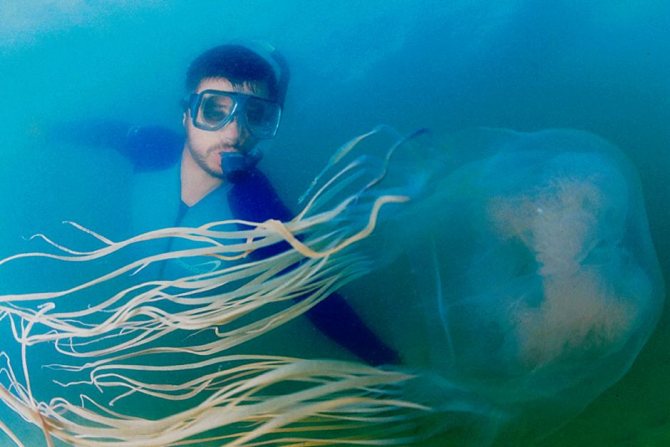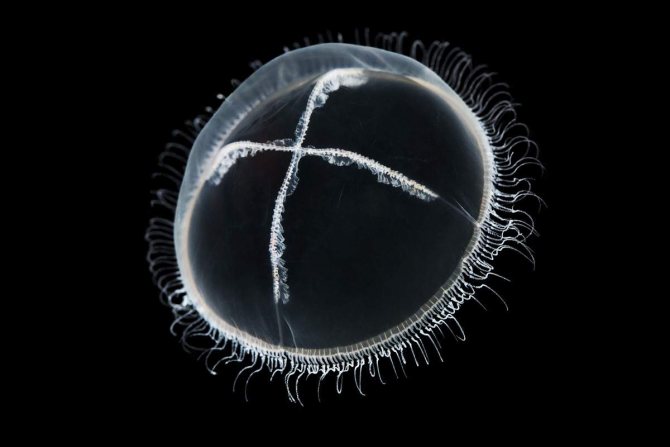General information
It is no secret that jellyfish are predators and are capable of stinging. Their tentacles are equipped with a special type of stinging cells - cnidocytes , which they need to hunt various prey, as well as to protect themselves from enemies.
The main food of these mobile hydroforms of cnidarians is zooplankton, incl. larvae, eggs and small fish representatives. Jellyfish, even weighing more than a hundredweight, are not able to withstand the sea current, therefore they are classified as plankton. Their type of movement is reactive - thanks to the contractions of the muscles of the walls of the umbrella, they are not capable of attacking a person.
The structure of a jellyfish
Involuntary contact with the smooth gelatinous parts is not dangerous to the health and integrity of the skin, while the stinging tentacles pose a real threat. There are several types:
- penetrants - are pointed threads that can be injected into the victim’s body for subsequent injection of burning toxic substances;
- glutinants - threads of a fairly long length with a sticky coating, their function is to stick to and immobilize the victim;
- volvents - have the appearance of short threads that are also capable of entangling the victim.
ICD-10 code: X26 Contact with poisonous marine animals and plants.
Questions and answers: what a tourist needs to know about jellyfish
| Question | Answer |
| Do jellyfish sting or bite? | Jellyfish do not have teeth, but their tentacles contain stinging cells. When a sensitive hair comes into contact with the victim’s body, a stinging thread with poison is ejected, which penetrates the skin. The poison spreads through the tissues, causing a burn. |
| Is a Black Sea jellyfish sting dangerous? | Black Sea representatives are not dangerous. But their bites can cause minor burns. |
| How can you treat a burn site? | The local population believes that the burn site can be lubricated with tomato juice, acetic acid solution or soda. |
| What is the best remedy for jellyfish stings? | There is no special remedy for stings, so you should try to avoid encounters with jellyfish. But if the meeting does take place, you need to help yourself, according to the instructions above. |
| What to apply to jellyfish stings? | After providing first aid, you can anoint the affected area with anti-inflammatory ointment Voltaren, Ichthyol ointment, or Tetracycline. |
| How to treat scars from jellyfish stings? | It is known that scar wounds heal very poorly, so you can use a special healing ointment for scars, Contractubex, Mederma. |

Medusa Aurelia - inhabitant of the Black Sea
The mirror-like surface of the ocean or sea is deceptive. Beneath it hide amazing translucent creatures - magnificent swimmers and fierce hunters. And despite the fact that the main source of food for these amazing creatures is fish, crustaceans, eggs, plankton, and people are not included in their diet, an encounter with jellyfish can be very painful.
When going on vacation to the sea, you should familiarize yourself with the flora and fauna of the new area, not only on land, but also at sea, in order to avoid encounters with dangerous representatives of nature. You should always have a minimum first aid kit with you for first aid, and now you know what to do if you are stung by a jellyfish.
Read also First aid for myocardial infarction
Pathogenesis
Only some species of box jellyfish, scyphojellyfish and hydromedusas can cause serious injuries to humans, although it is generally accepted that all adult individuals of the medusoid generation are distinguished by a developed structure of stinging tentacles that contain poisons. Even after the death of an individual, the poison remains toxic for some time, so playing with cornmouths washed ashore can also trigger a number of dangerous pathological reactions.
Zootoxins present in stinging cells are biologically active substances that can actively interact with biological structures; they are alkaloids , histamines , various enzymes and their inhibitors .
Treatment of jellyfish burn
It is advisable to begin treatment of a jellyfish burn immediately, while simultaneously calling an ambulance, because even a harmless small sea animal can lead to irreparable consequences. It is especially important to know what to do in case of a jellyfish burn for parents of young children, because even a small amount of poison can lead to extensive reactions.
Remember that after a jellyfish sting, you need to immediately get out of the water, place the patient in a cool place and examine the wound. It is important to carefully treat the wound - remove parts of the tentacles (only with gloves or using a dry towel, magnetic card, tweezers) that could be stuck in the thickness of the skin and then rinse with clean salt water. If you have baking soda, alcohol, vinegar or lemon on hand, you can use them, wetting the entire burn area. After first aid has been provided for a jellyfish sting, you must remember the following warnings:
- Do not rub, scratch, touch with bare hands, or treat the burn site with fresh water, brilliant green or iodine;
- if you have chest pain, nausea and other signs of general intoxication, you should contact your family doctor;
- Avoid exposing the burn area to direct sunlight;
- You should refrain from drinking alcohol for several days after the bite.
Classification
Depending on the effect of zootoxin, different jellyfish stings are distinguished:
- neurotoxic – having an effect on the nervous system;
- cytotoxic (dermatonecrotic) – cause local damage to cells and tissues;
- cardiotoxic – disrupting and paralyzing the functioning of the heart;
- hemolytic - destroys red blood cells - erythrocytes .
According to the severity of the jellyfish burn, it can be:
- mild (symptoms appear briefly and fragmentarily);
- average ( toxicosis has periods of exacerbation);
- severe (signs of intoxication are more pronounced and can last from several hours to a whole day).
How to protect yourself from being bitten
To avoid a jellyfish sting, you must follow certain rules:
- First familiarize yourself with the diversity of local species of these animals. Such a measure will not only help you avoid places that are dangerous for people, but will also make it possible to prepare to provide first aid in the event of an accident.
- Do not swim close to jellyfish. It should be noted that the longest tentacles of some ocean species are also the thinnest. As a result, they are not visible in muddy water, so they can suddenly cause harm even at a distance of several meters.
- Do not enter the sea during waves or storms - under such conditions, fragments of tentacles float freely in the water, fully retaining their activity.

Being close to a jellyfish poses a threat to a diver
Causes
The cause of pathological processes as a result of bites (more correctly, injections) of jellyfish are the zootoxins contained in their stinging tentacles. The most famous among them:
- neurotropic poison of the cross;
- nerve poison of physalia (intoxication is accompanied by severe pain, suffocation, convulsions and disappears after 1.5-2 hours);
- sea wasp venom, which can instantly paralyze the heart muscle, also has hemolytic and dermatonecrotic effects;
- the venom of chryazora or sea nettle consists of various enzymes, prostaglandins , histamine , serotonin , kinin-like substances and proteins with lethal cardiotoxic, hemolytic and dermatonecrotic effects;
- The poison of the Black Sea and Azov aurelias and cornerotes - although not deadly, poses a threat to the lives of children, allergy sufferers, for people with heart problems; if it comes into contact with mucous membranes (for example, the eyes), it can cause strong inflammatory reactions.
Dangerous species of jellyfish and their habitat
350 species of jellyfish swim in the waters of the seas and oceans. The list of especially poisonous animals is small:
- Aurelia aurita. The diameter of the dome is 40 cm. It lives in the Azov and Black Seas. A jellyfish sting is painless, but it causes a severe burn.
- Cornerot. The dome size is 2 meters or more. Resident of the Azov and Okhotsk Seas. The bite is painful, but not strong. It is provoked by his touching the animal.
- Sea wasp (a species of box jellyfish). Diameter 40 cm, length of tentacles - 15 cm. Homeland - shallow waters of Indonesia and Australia. The most dangerous species, killing in 3 minutes.
- Irukandji (also refers to box jellyfish). Size 15-20 mm, tentacles 10-15 times longer. Typical representative of Australia, Oceania. Jellyfish are extremely poisonous and cause acute heart failure.
Symptoms
The symptoms of a jellyfish sting, or more correctly, an injection, are similar in different species and usually develop rapidly. Typically, patients experience a skin irritant and general toxic effect:
- local development of swelling and redness;
- increasing burning pain;
- fever;
- chills;
- increased sweating;
- convulsions;
- allergic reactions;
- papular dermatitis - the skin may become covered with a large number of blisters and resemble a nettle burn;
- , painful shock may begin .
Manifestations of general intoxication can also be expressed in the form of disturbances in the gastrointestinal tract (nausea, vomiting, diarrhea), even if the burn is superficial and the poison does not enter the body. If zootoxin has a neurotoxic effect, then a person may experience hallucinations, delirium, drowsiness or agitation, disorientation , etc.
The condition may be more severe and the symptoms more pronounced if a person has been in contact with the jellyfish for a long time or has been attacked by several individuals.
Important! There are known cases when a jellyfish burn resulted in death, for example, the Wasp Jellyfish living near the Australian coast is deadly; death from its bite occurs literally after a few minutes.
The most dangerous jellyfish in the world is the wasp.
Cross jellyfish sting
As a result of contact with the actively poisonous jellyfish, the cross jellyfish, a person experiences disruption of the activity of all body systems: the action of the poison is aimed at blocking the H-cholinoreactive systems of neuromuscular synapses and parasympathetic ganglia, and also gives a histamine-liberatory effect.

Cross Medusa
The first precedent of a spider bite is considered not life-threatening, the second is fraught with consequences due to the development of anaphylaxis , and the third is even fatal.
The clinical picture of the effects of neurotropic poison occurs within 15-20 minutes and includes:
- increased body temperature;
- adynamia and drop in muscle tone;
- pain in the limbs and lower back;
- disturbances of consciousness, incl. hallucinations, delusions;
- disturbances in the functioning of the respiratory and cardiac systems, which have signs of suffocation ;
- short-term loss of hearing and vision;
- death is possible.
First aid, what to do after a jellyfish sting
Most jellyfish stings cause nothing more than discomfort and do not require medical attention. But if you observe a severe allergic reaction in yourself or another victim, the rash has spread over a large area of the body, or the bite was caused by a particularly poisonous individual, then minutes of delay may end badly. It is important to know what a jellyfish burn looks like in order to immediately begin therapeutic measures. First aid for a jellyfish sting is as follows:
- You need to get out of the water carefully and slowly. Panic and sudden movements will accelerate the absorption of toxic substances into the blood;
- remove remnants of tentacles from the skin. The stinging cells remaining in the body can introduce an additional portion of toxic substances into you and worsen the situation. They are removed using a plastic card, the blunt part of a knife, a nail file or other suitable object. It is strictly forbidden to take them with your bare hands. Carefully lift the tentacles and remove them from the surface of the body;
- Rinse the area of the jellyfish burn well with salted sea water or a prepared saline solution. Shaving foam treatment is also suitable. Such methods stop the spread of poison. What to do if a jellyfish stings your eye? Rinse it immediately under running water in large quantities. The mucous membranes are especially sensitive to toxic substances;
- Ice applied to the affected area will reduce pain and relieve swelling. If the pain is burning, you can use antihistamines and painkillers;
- A gauze compress soaked in ammonia or apple cider vinegar will help remove toxins. If there are none, you can use vegetable oil or sugar syrup;
- drink as much water as possible. The liquid will help quickly flush out toxins from the body.
Read also: Heatstroke. Symptoms, causes and first aid for heat stroke

Remember to drink as much water as possible after a jellyfish sting
After providing first aid for a jellyfish sting, you should take a horizontal position in the shade and move less. Even if the first therapeutic measures lead to relief of the condition, it is not recommended to refuse medical help. The lull in symptoms may return with renewed vigor. This is especially true when toxins get into the eyes, mouth and other mucous membranes.
The strength of the poison depends on the type of coelenterate animal. Black Sea jellyfish stings can be painful, especially if the lesion is extensive, but not fatal.
Tropical representatives can cause fatal burns. The stings of the jellyfish found in Vietnam can be very strong and fatal.
The proposed instructions give a clear description of what to do if you are stung by a jellyfish.
| Action | Description |
| To prevent the possibility of a bite when meeting a jellyfish, you need to calmly leave the water on the shore. Fright and hysteria increase the speed of blood circulation and enhance the absorption of toxic substances | |
| The bite site should be washed well with sea water or just salt water, or shaving foam. These methods reduce the spread of poison. If poison gets into your eyes, you need to rinse them with plenty of (preferably running) tap water. | |
| Use the blunt part of a knife, a towel, a nail file or a plastic card to lift the remaining tentacles and carefully remove them from the affected area of skin | |
| To reduce swelling and pain, apply a piece of ice to the affected area when bitten. | |
| Take a tablet of ketanov, ibuprofen or other available analgesic | |
| If there is a possibility of an allergic reaction, take a tablet of Diazolin, Suprastin or any other antihistamine | |
| Drinking plenty of clean water leads to the rapid removal of toxins from the body | |
| Burns from jellyfish stings suffered by children, the elderly, or people with allergies are more severe, so such patients need to go to a medical facility for special care. After examination, the attending physician will prescribe the necessary treatment. Severe burns may require hospital treatment |
When going on a sea holiday, ask your tour operator what dangers may await you in the water, what is best to take with you in your first aid kit, how to behave if you are stung by a jellyfish, and where to go for medical help.
Procedures and operations
An important procedure after a jellyfish sting is to remove all remnants and parts of the hydroid's tentacles. You can do this yourself, preferably immediately. To do this, it is best to use a dry, hard towel, a credit card, but under no circumstances sharp objects!
It is enough to perform smooth scraping movements without injuring other integuments and without touching the burn site with your hands or other bare parts of the body.
Removing goads with a credit card
What is strictly forbidden to do after a bite
Lack of awareness leads to incorrect actions on the part of the victim and subsequent complications. It is strictly forbidden to rub the affected areas, even if they are very itchy. Such actions will lead to a rush of blood and activation of stinging cells. The poison in them will begin to be released faster and penetrate the skin.
Never use fresh water to wash burns. This is due to the fact that stinging cells, under the influence of water whose salinity is lower than the salinity of sea water, begin to disintegrate very quickly and release toxins abundantly. Fresh water can be used if all remnants of tentacles have been removed from the skin.
No matter how urine therapy is advocated for a jellyfish sting, it is not advisable to do this. You don’t know the percentage of urine salinity, and if it is not sufficient, you can worsen the situation. Also, urine may contain microorganisms that, if they enter an open wound, can cause infection.
Read also Mercury vapor poisoning. Symptoms, treatment, first aid, consequences
Treating the bite with iodine or brilliant green will increase irritation and inflammation, spreading it to healthy areas of the skin. Don't try to drown out unpleasant symptoms with alcohol. This will cause the poison to spread inside.
If you are stung by a jellyfish, it is prohibited:
- rub the affected area. In this case, you can injure the skin and increase the release of toxic substances from stinging cells;
- touch the burn site with unprotected hands to avoid getting a burn on your hands;
- Rinse the stung area with fresh water. Fresh water will cause cell destruction and this will only increase the pain, so it is better to use sea water. The exception is if the poison gets into the eyes;
- rub your eyes with poison-contaminated hands;
- sunbathe in the sun until the burn goes away.
You should not drink alcoholic beverages - alcohol enhances the effect of the poison.











